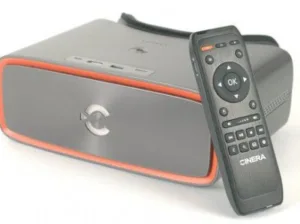Founded in 2014, the mission of Cinera Inc. (Newark, DE) has been to develop a product to address what they feel is an opportunity in an under served market. The company web site describes the opportunity in these terms: “What if you could have the immersive audio and video experience of a movie theater from the comfort of your own couch?”

Cinera calls their product an “Immersive Personal Theater” headset. The basis of the product’s design is the use of two displays each with a resolution of 2560 x 1440. This is eight times that of an iPhone 7+ and three times that of a movie theater screen. The company claims that there are two important advantages to this approach.
First, since each of the user’s eyes has its own individual display and light path, the reduction in image quality is minimized.
The second advantage, the company says, derives from that fact that most movies have an aspect ratio of 2.39 to 1. This means that, when a movie is presented on a typical headset, keeping this ratio results in using only about 47% of the pixel resolution of the display. This, in turn, means that image quality suffers. The Cinera dual screen approach, on the other hand, uses about 95% of each display’s pixel resolution, also contributing to the production of an image having superior quality.
Another factor recognized by the company as important in enhancing the sense of user immersion is the field of view. After extensive testing, Cinera determined that the optimum combination of clear image and the feeling of immersion is to have a 66º horizontal field of view. Indeed, the Cinera headset is designed to have a 66º horizontal field of view.
Other specifications reported for the Cinera headset include the following.
- CPU Quad Core Cortex-A17 up to 1.8 GHz
- GPU Mali-T764
- 5 mm audio jack
- USB 2.0
- Memory 2 GB
- Storage 16 GB
- WiFi 802.11 a/b/g/n
- Bluetooth sensors BT 4.0
- Gyroscope, accelerometer, magnetometer
- Fits over glasses
- Pupil distance adjustment 56 mm – 71 mm
- OS Android 6.0.1
A further advantage claimed for the dual display approach is that it can produce a stereoscopic 3D image that is said to be brighter and of higher quality than approaches based on a single display.
Serving a more specialized application, Cinera offers a so-called First Person View head mount. This hardware mounts the headset to the user’s head and is intended to allow the user to control a drone camera with a tilt of their head. The mount includes a battery that can operate the headset for up to four hours.
Cinera recognizes that wearing a headset for a prolonged period of time can be physically stressful, particularly to the user’s neck. The company has addressed this problem with the availability of a hardware accessory, the hands free Cinera arm. With its built in pump, the user can move the headset to practically any position without a lot of force.
On additional piece of hardware that the company hopes to offer is a so-called 2-in-1 remote control. The development of this component is a “stretch goal” of their fund raising effort as described below.
The principle hardware components in the Cinera headset product are illustrated in the figure below.
 Left: The Cinera headset and the remote control. Center: The hands free Cinera arm. Right: The First Person View head mount.
Left: The Cinera headset and the remote control. Center: The hands free Cinera arm. Right: The First Person View head mount.
The Cinera headset can be connected to other devices and applications owned by the user. Streaming apps such as Netflix, YouTube and Hulu can be installed. The user can also play files from their video archive either using a micro-SD card or their network server. In addition, the headset can be connected to a Blu-ray player, gaming console or computer by way of a HDMI Input. The company reports that it is working to upgrade the HDMI 1.4a currently in the Cinera to 1.4b so as to support 2.5K resolution input.
A video that introduces and discusses the Cinera headset can be found at the end of this article.
Cinera claims that all of the major features of the headset have been developed and are in the fine tuning stage. The company said that it has produced about 50 prototype units to troubleshoot product design and assembly before preparing final tooling. Additional funding is needed to produce the tooling. To this end, the company is using a Kickstarter campaign which can be found here. At the time this article is written, $255,573 has been pledged by 496 backers against a goal of $50,000. The project can, therefore, be expected to fund when the campaign closes on September 18, 2017. Based on this, the company expects to start mass production of the headsets in November, 2017. The price of the kit is listed on the company web site at $799. –Arthur Berman

